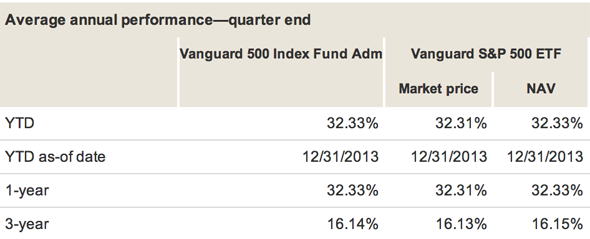How does mutual fund NAV affect performance of a fund
Post on: 20 Май, 2015 No Comment

by Manshu on February 21, 2011
There were two recent comments that prompted me to write this post, and both had to do with mutual fund NAV (Net Asset Value), and how they impact the performance of a fund.
The truth is that mutual fund NAVs have no impact on the performance of a mutual fund, and you should ignore the NAV while making a decision to buy a mutual fund, and it shouldnt figure in your decision process at all.
One reader asked me if the NAV and performance of a fund are inversely related, and I think that question has its roots in listening to people touting benefits of investing in a mutual fund NFO, and getting a mutual fund at a ten rupee NAV.
In reality, there is no relationship between the NAV and performance of a mutual fund. The funds NAV will have absolutely no bearing on how its going to perform in the future or how it has performed in the past.
The second comment was about the relationship between a dividend payout and the NAV of a mutual fund, and even that doesnt have any effect on performance.
The NAV of a mutual fund will adjust according to the dividend payment, but that doesnt mean you stand to gain or lose anything based on when you choose to buy the mutual fund.
Lets take an example to understand this. Suppose you want to start up a mutual fund of your own, and give your family members a chance to invest with you.
You go ahead and shoot out an email to all family members who you think are interested in it, and ask them how much money they are going to invest with you.
Being as smart as you are you get a lot of responses from your family members, and at the end of your subscription period you get the following sums:
At an exchange rate of 45 rupees to a dollar you convert your 10,000 USD and see that you have Rs. 450,000. So, now your total assets under management are Rs. 9,50,000.
You send out a letter to all your subscribers with the information that the fund has collected Rs. 950,000 and you will send them a quarterly report of your progress.
At the end of the 3 months, you see that your investments have grown smartly, and that you have grown the money to 10,45,000.
Most of your subscribers are happy, but the cousin in US who invested in your fund says that he cant really understand if you did good or bad, and needs a simple way to compare your performance with the Dow.
You tell him that the fund made 10% in that quarter, and the Dow gained by 3%, and add that from the next statement onwards you are going to send a percentage gain along with the funds under management as well.
Time goes by, and you forget to wish your uncle on his 50th birthday. He does what any loving uncle would do withdraw his Rs. 50,000 investment from your fund to teach you a lesson. Ouch.
You are the honest nephew, so you tell your uncle that his original investment grew by 10% in the 3 months you handled it so you hand him over a check of Rs. 55,000.
The market remains stagnant in the next quarter, and the fund doesnt move at all. You shoot an email to your readers telling them that the fund value is now at 9,90,000 and this quarter has been no profit no loss for it.
You get a barrage of emails the next morning from your subscribers who ask you what kind of a scammy outfit youre running since the value came down from 10,45,000 last quarter to 9,90,000 this quarter, and you saw no loss at all?
You are at a loss on what to do, and decide to call up your good friend Loney who tells you that you need to split up the fund into units, and assign a NAV to the fund. Then tell each of your subscribers how many units they own based on their initial investment, and declare the NAV every quarter instead of declaring the total assets under management. The NAV is not impacted by redemption or new investment, and your current subscribers will better understand your fund performance.
Aha so now you know why you need that blasted NAV in the first place.
Now, the next question is what to base it on.
You decide that you are going to go the extra mile and make it really easy for your US subscribers to compare your funds performance with the DOW and make one unit of your fund equivalent to one unit of the DOW!
You see that the Dow closed at 12,391.25 on February 18th, and decide that one unit of your fund will also represent that sum.

So you divide the initial investment of Rs. 950,000 with 12,391.25 and arrive at 76.67 units. In this case the NAV of 1 unit of your fund is equal to 12,391.25 at the start, and you have 76.67 units in your fund.
You then tell each of your subscribers how many units they own based on how much money they invested with you. When your aunt sees your email about one unit having a NAV of Rs. 12,391.25 she flips out and calls you asking whats this DOW, and why should she care about it.
After listening to your explanation she understands what youre doing but wants you to compare your performance to gold instead of DOW because everyone knows gold is the next big thing, and you should at least better that.
You try to reason with her, but when she threatens to complain to your mom you go back home, and see that one gram of gold is about Rs. 2,000, so based on that you say that one unit of your mutual fund will be Rs. 2,000 as well, and the total units will now be 450 instead of the earlier 76.67 based on the initial corpus with you.
You draft the email informing subscribers of this change, but before hitting the send button decide to take a second opinion from your brother in Delhi.
When you call him up and tell him about the Rs. 2,000 NAV he is livid. He hadnt read your earlier email, and its good that he hadnt because the only reason he invested in your mutual fund was to get a 10 rupee NAV!
Whats the point of investing with you if you give him such an expensive NAV? He demands you to give him a 10 rupee NAV immediately.
You are at the verge of going insane now, and call me up to ask me what you should do. Unfortunately Im too busy sending people their infrastructure bond statements and doing the needful so I ask you to call up my buddy Shiv who is an adviser.
Shiv tells you to take it easy and keep the NAV at Rs. 10 and placate everyone. It doesnt matter what the NAV is anyway, its just a number you pull out from a hat. This way at least everyone will be happy.
You take this sound advice, and shoot out an email the next day saying that the initial NAV was Rs. 10, and that the fund had 95,000 units, and tell everyone their units individually as well.
You wait for angry emails, but no one replies no news is good news you decide, and smile for the first time wondering how easy it is to pull out any NAV from your hat, and get everyone all riled up for nothing.
You can make up any NAV you want at the start of the fund, it doesnt matter if its 10 or 10,000, so ignore NAVs while making your investing decision.














